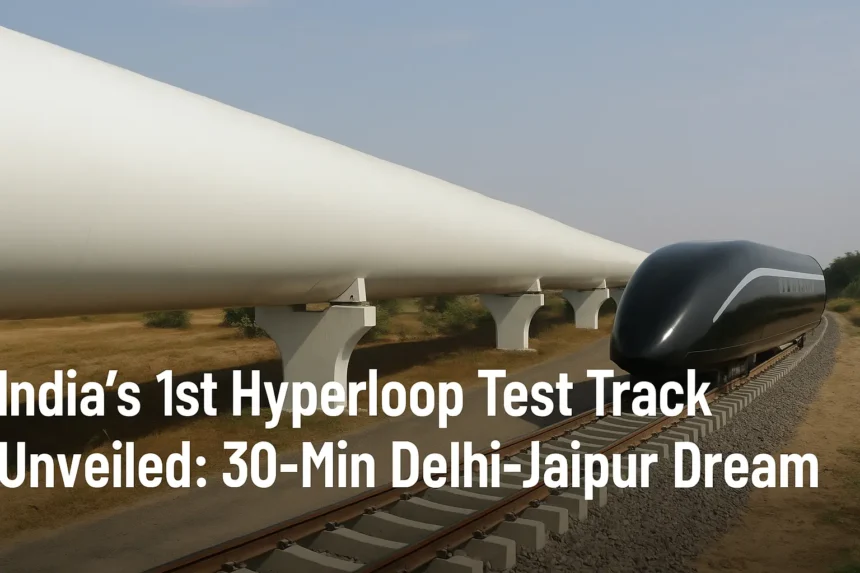India’s 1st Hyperloop Test Track: A Giant Leap for Public Transport
India’s High-Speed Leap: The Future of Travel Begins Now
Imagine traveling from Delhi to Jaipur in just 30 minutes—yes, you read that right. No traffic, no airport queues, just lightning-fast travel in a futuristic capsule. Thanks to India’s first-ever Hyperloop test track, that dream might soon become a reality.
In a landmark achievement for the nation’s public transportation system, IIT Madras, with support from Indian Railways, has developed a 410-meter Hyperloop test track, setting the stage for a revolution in how we travel across the country.
What is Hyperloop and Why Should You Care?
Hyperloop is a breakthrough transportation technology where pods or trains travel through vacuum tubes at ultra-high speeds—up to 1,100 km/h. Since the tubes are nearly airless, there’s minimal resistance, allowing the pods to glide smoothly and safely.
The result? Incredibly fast, quiet, and energy-efficient travel. It’s not just about speed—it’s about changing the way we move.
India’s First Step Towards a Hyperloop Future
The Indian government is backing this future-ready mode of transport in full swing. The Railway Ministry recently released a video showcasing the completed test track, highlighting India’s commitment to next-gen infrastructure.
This isn’t just a cool science project. It’s a functional prototype—a 410-meter stretch that will be used for upcoming trials to test feasibility, safety, and performance.
And once the test runs succeed, we could see commercial Hyperloop corridors linking major cities like Delhi-Jaipur and Mumbai-Pune—cutting travel time from hours to mere minutes.
Why is This a Big Deal?
Because this isn’t just faster than a bullet train—it’s a complete reimagination of mass transport. While high-speed trains like Japan’s Shinkansen and China’s maglev can reach speeds of 300–600 km/h, the Hyperloop targets over 1,000 km/h, making it the fastest ground-based transport system ever conceived.
Compared to bullet trains:
- Bullet Train: ~350–450 km/h
- Hyperloop: Up to 1,100 km/h
This means a journey like Delhi to Jaipur (280 km), which currently takes 4–6 hours by road or 1 hour by air (plus check-in), could be done in just 30 minutes.
Energy-Efficient and Environmentally Friendly
- Beyond speed, Hyperloop is also a green solution.
- It uses electric propulsion and magnetic levitation.
- Operates in sealed vacuum tubes, reducing air drag and noise pollution.
- Consumes significantly less energy per passenger compared to planes or cars.
- Offers a sustainable alternative for India’s congested and polluted urban corridors.
Hyperloop could become a key part of India’s mission to build clean, efficient, and modern transport infrastructure.
What Happens Next?
The next phase involves extensive testing on the 410-meter track. Engineers will simulate real-world conditions to measure safety, efficiency, acceleration, braking, and more. If all goes well, full-scale implementation plans will begin.
The timeline may still span a few years, but the foundation is laid, and India is officially in the race with global leaders like China, Japan, and the UAE, all working on similar systems.
Global Hyperloop Race: Who’s Winning?
India isn’t alone. Countries worldwide are racing to bring Hyperloop to life.
- China’s T-Flight project is targeting similar speeds (~1,000 km/h).
- Elon Musk’s concept has inspired multiple startups, including Virgin Hyperloop.
- Japan, known for its bullet trains, is also investing in magnetic levitation tech to up its speed game.
But with this new test track, India is one of the few nations to build and operationalize a full-scale prototype—a bold step toward leading the Hyperloop revolution.
Why This Matters to You
Hyperloop isn’t just for tech lovers—it’s for everyone.
- Daily commuters could save hours every week.
- Students and workers could live in one city and work in another.
- Businesses could thrive with faster logistics.
- Tourism could explode with faster, easier travel.
And most importantly, it can make high-speed, clean travel affordable and accessible to millions.
Final Thoughts: A Future You Can’t Ignore
We stand at the edge of a transportation revolution. With the Hyperloop test track complete, India has shown it’s ready to embrace the future.
If this tech proves successful, India’s transport map could be redrawn forever—linking cities in minutes, slashing carbon footprints, and transforming how 1.4 billion people move.
So next time you’re stuck in traffic or waiting for a delayed flight, remember—your next ride might just be in a vacuum tube, traveling at 1,100 km/h.
Ready for the Future?
Stay updated on India’s Hyperloop journey, new tech, and transport revolutions.
Follow us for more insights, updates, and deep dives into the future of travel.
Most read: https://tnheadlines24.com/indian-railways-to-introduce-medical-kits/
Disclaimer: The information provided in this article is for general informational purposes only. While every effort has been made to ensure the accuracy of the content, developments and data related to Hyperloop technology are constantly evolving. TN HEADLINES24 is not responsible for any decisions made based on the information presented here. Readers are advised to consult official sources for the latest updates and developments.

